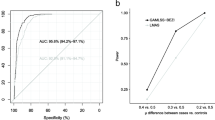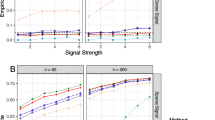Abstract
The human breast milk microbiome (HMM) has far reached health implications for both mothers and infants, and understanding the structure and dynamics of milk microbial communities is therefore of critical biomedical importance. Community heterogeneity, which has certain commonalities with familiar diversity but also with certain fundamental differences, is an important aspect of community structure and dynamics. Taylor’s (1961) power law (TPL) (Nature, 1961) was discovered to govern the mean–variance power function relationship of population abundances and can be used to characterize population spatial aggregation (heterogeneity) and/or temporal stability. TPL was further extended to the community level to measure community spatial heterogeneity and/or temporal stability (Ma 2015, Molecular Ecology). Here, we applied TPL extensions (TPLE) to analyze the heterogeneity of the human milk microbiome by reanalyzing 12 datasets (2115 samples) of the healthy human milk microbiome. Our analysis revealed that the TPLE heterogeneity parameter (b) is rather stable across the 12 datasets, and there were approximately no statistically significant differences among ¾ of the datasets, which is consistent with the hypothesis that the heterogeneity scaling (i.e., change across individuals) of the human microbiome, including HMM, is rather stable or even constant. For this, we built a TPLE model for the pooled 12 datasets (b = 1.906), which can therefore represent the scaling rate of community-level spatial heterogeneity of HMM across individuals. Similarly, we also analyzed mixed-species (“averaged virtual species”) level heterogeneity of HMM, and it was found that the mixed-species level heterogeneity was smaller than the heterogeneity at the previously mentioned community level (1.620 vs. 1.906).



Similar content being viewed by others
Data availability statement and ethical approval
All datasets used in this study are available in the public domain and their sources are noted in Table S1. No data related to human subjects were used in this study, and no ethical approval was inapplicable. The original contributions presented in the study are included in the article/Supplementary Material, and further inquiries can be directed to the corresponding authors.
References
Aakko J, Kumar H, Rautava S et al (2017) Human milk oligosaccharide categories define the microbiota composition in human colostrum. Benef Microbes 8(4):563–567
Agostoni C, Braegger C, Decsi T et al (2009) Breast-feeding: a commentary by the ESPGHAN Committee on Nutrition. J Pediatr Gastroenterol Nutr 49(1):112–125
Boix-Amorós A, Martinez-Costa C, Querol A et al (2017) Multiple approaches detect the presence of fungi in human breastmilk samples from healthy mothers. Sci Rep 7(1):13016
Carr LE, Virmani MD, Rosa F et al (2021) Role of human milk bioactives on infants’ gut and immune health. Front Immunol 12:604080
Civardi E, Garofoli F, Tzialla C et al (2013) Microorganisms in human milk: lights and shadows. J Matern Fetal Neonatal Med 26(S2):30–34
Cohen JE, Meng X (2015) Random sampling of skewed distributions implies Taylor’s power law of fluctuation scaling. Proc Natl Acad Sci U S A 112(25):7749–7754
Cohen JE, Saitoh T (2016) Population dynamics, synchrony, and environmental quality of Hokkaido voles lead to temporal and spatial Taylor’s laws. Ecology 97(12):3402–3413
Collingridge DS (2013) A primer on quantitized data analysis and permutation testing. J Mixed Methods Res 7:79–95
Corona-Cervantes K et al (2020) Human milk microbiota associated with early colonization of the neonatal gut in Mexican newborns. PeerJ 8:e9205
Fernández L, Langa S, Martin V et al (2013) The microbiota of human milk in healthy women. Cell Mol Biol (noisy-Le-Grand) 59(1):31–42
Fouhy F, Ross RP, Fitzgerald GF et al (2012) Composition of the early intestinal microbiota: knowledge, knowledge gaps and the use of high-throughput sequencing to address these gaps. Gut Microbes 3(3):203–220
Grilli J (2020) Macroecological laws describe variation and diversity in microbial communities. Nat Commun 11(1):4743
Guan Q, Ma Z (2014) Ecological analysis of human milk microbiome. Chin Sci Bull 59(22):2205–2212
Hunt KM, Foster JA, Forney LJ et al (2011) Characterization of the diversity and temporal stability of bacterial communities in human milk. PLoS ONE 6(6):e21313
Jimenez E, De Andres J, Manrique M et al (2015) Metagenomic analysis of milk of healthy and mastitis-suffering women. J Hum Lact 31(3):406–415
Jost T, Lacroix C, Braegger C et al (2013) Assessment of bacterial diversity in breast milk using culture-dependent and culture-independent approaches. Br J Nutr 110(7):1253–1262
Keeling M, Grenfell B et al (1999) Stochastic dynamics and a power law for measles variability. Philos Trans R Soc b: Biol Sci 354(1384):769–776
Li WD, Ma ZS (2019) Diversity scaling of human vaginal microbial communities. Zool Res 40(6):587–594
Li L, Ning P, Ma ZS (2021) Structure and dynamics of the breast tissue microbiomes under tumor influences: an approach with neutral, near-neutral, and niche-neutral hybrid models. Front Microbiol 12:614967
Lopez-Alarcon M, Villalpando S, Fajardo A (1997) Breast-feeding lowers the frequency and duration of acute respiratory infection and diarrhea in infants under six months of age. J Nutr 127(3):436–443
Ma ZS (1991) Further interpreted Taylor’s power law and population aggregation critical density. Trans Ecol Soc Chin 1:284–288
Ma ZS (2015) Power law analysis of the human microbiome. Mol Ecol 24(24):5428–5445
Ma ZS (2020a) Critical network structures and medical ecology mechanisms, underlying human microbiome associated diseases. iScience 23(6):101195
Ma ZS (2020b) Heterogeneity-disease relationship in the human microbiome associated diseases. FEMS Microbiol Ecol 96(7):fiaa093
Ma ZS (2021) Spatial heterogeneity analysis of the human virome with Taylor’s power law. Comput Struct Biotechnol J 19:2921–2927
Ma ZS, Taylor RAJ (2020) Human reproductive system microbiomes exhibited significantly different heterogeneity scaling with gut microbiome, but the intra-system scaling is invariant. Oikos 129:903–911
Ma ZS, Ellison AM (2021) In silico trio-biomarkers for bacterial vaginosis revealed by species dominance network analysis. Comput Struct Biotechnol J 19:2979–2989. https://doi.org/10.1016/j.csbj.2021.05.020
Ma ZS, Zhang YP (2022) To mask, or not to mask. Alice Bob’s Dating Dilemma. https://doi.org/10.1101/2022.04.14.22273886
Ma ZS, Guan Q, Ye C et al (2015) Network analysis suggests a potentially “evil” alliance of opportunistic pathogens inhibited by a cooperative network in human milk bacterial communities. Sci Rep 5:8275
Martín R, Langa S, Reviriego C et al (2003) Human milk is a source of lactic acid bacteria for the infant gut. J Pediatr 143(6):754–758
Petherick A (2010) Development: mother’s milk: a rich opportunity. Nature 468(7327):5–7
Reuman DC, Gislason H, Barnes C et al (2014) The marine diversity spectrum. J Anim Ecol 83(4):963–979
Reuman DC, Lei Z, Sheppard LW et al (2017) Synchrony affects Taylor’s law in theory and data. Proc Natl Acad Sci 114(26):6788–6793
Singh RP, Niharika J et al (2022) Recent understanding of human milk oligosaccharides in establishing infant gut microbiome and roles in immune system. Food Res Int 151:110884
Stinson L et al (2021) The human milk microbiome: who, what, when, where, why, and how? Nutr Rev 79(5):529–543
Stumpf MPH, Porter MA (2012) Critical truths about power laws. Science (new York, NY). 335(6069):665–666
Taylor LR (1961) Aggregation, variance, and the mean. Nature 189(4766):732–735
Taylor LR (1984) Assessing and interpreting the spatial distributions of insect populations. Ann Rev Entomol. 29(1):321–357
Taylor LR (1986) Synoptic dynamics, migration and the Rothamsted Insect Survey. Presidential address to the British Ecological Society. J Anim Ecol 55:1–38
Taylor LR (2019) Taylor’s power law: order and pattern in nature. Academic Press, Cambridge, p 639
Taylor LR, Perry JN (1983) Behavioural dynamics. Nature 303(5920):801–804
Taylor LR, Perry JN, Woiwod IP et al (1988) Specificity of the spatial power-law exponent in ecology and agriculture. Nature 1332(6166):721–722
Urbaniak C, Angelini M, Gloor GB et al (2016) Human milk microbiota profiles in relation to birthing method, gestation and infant gender. Microbiome 4:1
Ward TL, Hosid S, Ioshikhes I et al (2013) Human milk metagenome: a functional capacity analysis. BMC Microbiol 13(1):116–116
Funding
This research received funding from the following sources: The State Key Laboratory of Genetic Resources and Evolution (#GREKF21-06#, GREKF20-06, GREKF19-07) and Yunnan Province Local University (Part) Basic Research for Youths (No. 202001BA070001-100 and 202101BA070001-018); National Science Foundation of China (Grant #12161033); The Yunnan Provincial Department of Education Scientific Research Fund Project (No. 2022J0896); National Natural Science Foundation (NSFC) (Grant No. 31970116).
Author information
Authors and Affiliations
Contributions
HC and BY conducted the data analysis and wrote the manuscript; We appreciate the data curation support from LW Li and WM Xiao (from Computational Biology and Medical Ecology Lab, Chinese Academy of Sciences). All authors approved the submission.
Corresponding author
Ethics declarations
Conflict of interest
The authors declare that they have no known competing financial interests or personal relationships that could have appeared to influence the work reported in this paper.
Additional information
Communicated by Erko Stackebrandt.
Publisher's Note
Springer Nature remains neutral with regard to jurisdictional claims in published maps and institutional affiliations.
Supplementary Information
Below is the link to the electronic supplementary material.
Rights and permissions
Springer Nature or its licensor holds exclusive rights to this article under a publishing agreement with the author(s) or other rightsholder(s); author self-archiving of the accepted manuscript version of this article is solely governed by the terms of such publishing agreement and applicable law.
About this article
Cite this article
Yi, B., Chen, H. Power law analysis of the human milk microbiome. Arch Microbiol 204, 585 (2022). https://doi.org/10.1007/s00203-022-03171-7
Received:
Revised:
Accepted:
Published:
DOI: https://doi.org/10.1007/s00203-022-03171-7




